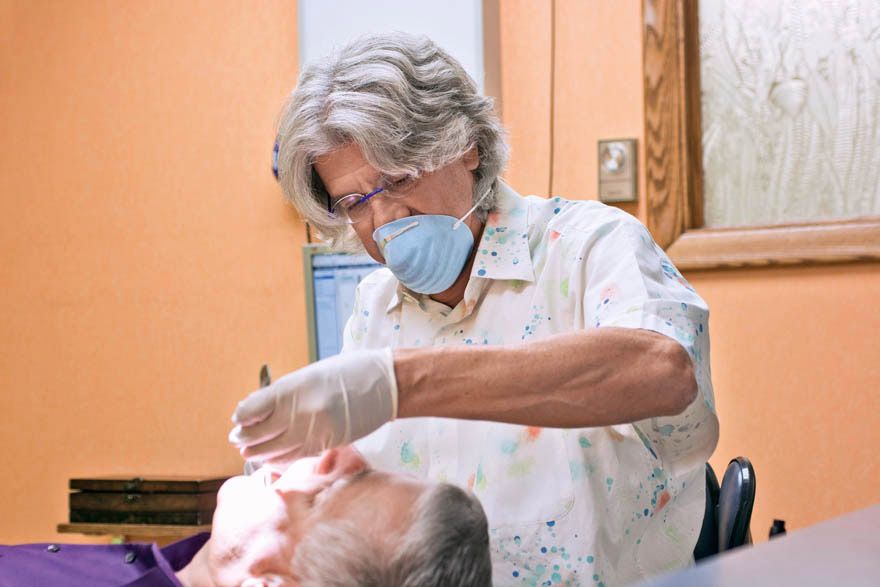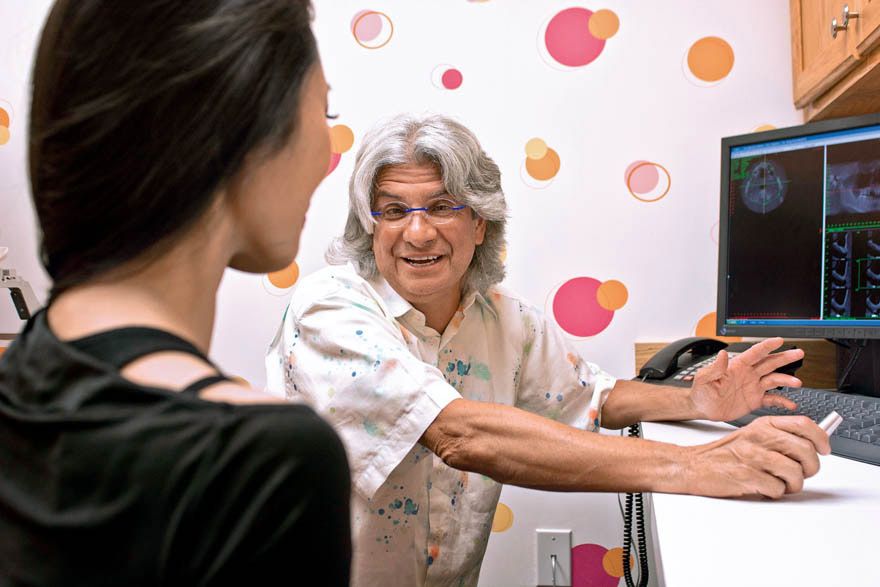Dr. Fugazzotto, innovative implant materials and surfaces have a significant influence on dental implantology. Where do you see the benefits?
Paul Fugazzotto: The impact on clinical practice is indeed on a number of levels, including the expansion of therapeutic possibilities, the patient experience and practice management ramifications. The utilization of shorter implants affords the opportunity to employ implant therapy in previously untenable situations. In addition, the course of therapy is influenced both with regard to complexity of care and overall time of treatment. For the patient, the therapy becomes simpler, less invasive [1], less costly, and less traumatic. The net result is a better patient experience. The same is valid for the practice management ramifications: patient acceptance of therapy increases as treatment becomes simpler and less expensive. Such increased acceptance impacts the surgical specialist, the restorative dentist, and the “all-in-one” practitioner. The surgical specialists are further impacted as their referring partners become more likely to refer a given patient for implant therapy, due to the simplification of care through the use of innovative implant materials and surfaces.
“Implant materials influence much more than merely implant selection. Treatment planning is altered, new treatment end points are defined and execution of therapy is simplified.”
How is your implant selection influenced by material and surface properties?
Paul Fugazzotto: Implant materials influence much more than merely implant selection. Treatment planning is altered, new treatment end points are defined and execution of therapy is simplified. Naturally, the utilization of the Straumann® Roxolid® material, with its superior strength, allows the clinicians to confidently place narrower implants, to treat given situations with fewer implants, and to place implants with more confidence in more challenging scenarios, such as in patients demonstrating significant para-functional habits. Innovative implant surfaces do more than speed up the course of therapy. The superior osseointegrative bond offers significant clinical advantages when dealing with poorer-quality bone.
“There is no patient of mine who deserves to be treated differently, when such an advanced surface technology like SLActive® is readily available.”
What kind of data do you need to have confidence in using a new implant or surface technology?
Paul Fugazzotto: I have a simple criterion when deciding whether or not to employ a new implant or surface technology. Would I place said implant in my mouth? If the answer is no there is no reason to discuss the implant any longer. For the answer to be yes, I require specific types of data. This data must be the result of independent unbiased research, carried out by reputable people and or organizations. In addition to basic science and histology, I expect to see clinical data with well-defined treatment end points, in sufficient numbers to underscore the efficacy of utilization. This is one of the many reasons the ITI (International Team for Implantology) is so valuable to us as clinicians. The ITI carries out unbiased basic science and clinical research. Results built upon this research by clinicians throughout the world further support the use of innovative implants and surface technologies.
What are your experiences with Straumann’s hydrophilic surface SLActive®?
Paul Fugazzotto: I have utilized exclusively SLActive® implants since they became available for clinical practice. Why? Because an implant surface which has demonstrated faster osseointegration and a superior osseointegrative bond is the first choice for me. Which patients deserve to be treated differently, when such an advanced surface technology like SLActive® is readily available?
“How can such a material not transform dental implantology as it becomes available in more implant diameters and lengths?”
Can you tell us something about the Straumann® Roxolid® Ø3.3 mm implants which you have been using regularly?
Paul Fugazzotto: My experiences with the Roxolid® Ø 3.3 mm implants are the same as my experiences with other Straumann® implants. I have encountered no implant fracture, and am positive that these implants, with the SLActive® surface, utilized in appropriately treatment-planned and -executed situations, will demonstrate a success rate of up to 99 % over time. I specifically use the term “success” rather than “survival,” as I assess implants both radiographically and through bone sounding to determine their long term stability. Roxolid® implants allow clinicians to place implants without fear of fracture, due to their superior strength [2]. So, I am confident that, utilized appropriately, Roxolid® implants offer at least as high an implant success rate as Straumann® implants with SLActive® surface in general.
Do you see benefits of Straumann® Roxolid® implants over comparative diameter-reduced competitor implants?
Paul Fugazzotto: The superior strength properties of Roxolid® afford a greater “safety margin” with regard to implant deformation and or fracture, which is a clear advantage over other reduced-diameter implants. Simply put, Roxolid® in combination with SLActive® offers advantages to clinicians, and more importantly to the patients they serve. Do you see a potential for Roxolid® to further transform dental implantology if it were available on more implant diameters and lengths? In my opinion, the development of the Roxolid® material is one of the most significant advances in implant therapy in the last 20 years. Companies and clinicians constantly tout new implant morphologies, various restorative connections, and surface technologies. While these are important, the Roxolid® material represents a more basic evolutionary phase in implantology. The material the implant is composed of offers superior strength over titanium, regardless of the implant morphology, restorative connection or surface technology. How can such a material not transform dental implantology as it becomes available in more implant diameters and lengths?
“I have a simple criterion when deciding whether or not to employ a new implant or surface technology. Would I place said implant in my mouth? If the answer is no there is no reason to discuss the implant any longer.”
Most implantologists follow the principle of choosing the largest and longest implant possible. If scientifically proven, well-established materials would allow you to use smaller diameters or shorter implants, how would this influence your daily work?
Paul Fugazzotto: I do not accept the premise of this question. The more progressive, experienced clinicians and teachers I interface with, the majority of whom are ITI fellows or members, no longer follow the dogma of choosing the largest and longest implant possible in a given situation. The introduction of wider implants in the 1990s, and their utilization in a variety of situations led to disastrous results with regard to buccal bone resorption and other post-operative sequellae, giving clinicians reason to pause. We have learned from this debacle, and understand that adequate bone must be present around an implant to withstand functional forces over time, and thus help ensure long-term implant success. A number of “postulates” have also been disproven throughout the years in numerous finite element anilities and independent clinical field research. These so-called postulates include the utilization of longer implants for greater stability; employing longer implants when a narrow implant is placed to “make up” for lost surface area; and the need to exceed a 1:1 implant-crown ratio. None of these teachings have held up well under scrutiny. Forces placed upon implants are transmitted primarily to the peri-implant crestal bone. Such transmission has nothing to do with implant length and everything to do with implant diameter. Crown-to-implant ratio has been shown not to be a significant factor in implant failure, when implants are placed in adequate bone, where an appropriate occlusion has been established and parafunctional habits managed.
“The expanded portfolio will simplify many patient care situations. This means therapy will be more accessible to patients ill-suited to extensive regenerative therapies, to patients with greater financial limitations, and to patients with significant resorption which places vital structures at risk should implants be inserted.”
“Shorter” implants (the precise length dependent upon the individual clinician’s definition) demonstrate long-term cumulative success rates equal to their longer counterparts. In my practice, when an implant is not placed in an extraction socket where greater implant length is required to attain primary stability, the average implant length I employ is 8mm. I am very comfortable with an 8 mm long Straumann® Tissue Level implant with a Wide Neck platform to replace a missing molar. Simply put, the SLActive® surface technology gives me the confidence to place such implants. The introduction of Roxolid® material allows me to utilize innovative implant designs with narrower bodies and appropriate platforms in a variety of situations.
Where is the paradigm of using the largest and longest implant still valid and where do you consider this differently in your daily practice?
Paul Fugazzotto: In my opinion, the paradigm of using the largest and longest implant in a given situation is an outmoded way of thinking. I am more concerned with having an adequate diameter for establishment of a sufficient osseointegrated bond between the implant and the peri-implant crestal bone, which is housed in adequate bone to withstand functional forces over time (at least 2 mm of supporting bone at the line angles of the buccal and lingual/alveolar crests) and avoidance of trauma and maceration of thin buccal extraction socket walls at the time of implant placement. I see no advantage to the utilization of the largest and longest implant possible in any situation.
“A number of ‘postulates’ have also been disproven throughout the years in numerous finite element anilities and independent clinical field research.“
In a formerly published article you talked about reducing the implant diameter or using short implants. Which benefits do you see behind these considerations?
Paul Fugazzotto: The advantage of shorter or narrower implants include fewer invasive procedures, avoidance of vital structures, a lessening of the need for regenerative therapy, and a simplification of regenerative therapy when required. While I do not advocate you stepping down more than one level in implant diameter to utilize narrower implants, I do believe that narrower implants will become an ever increasing part of any progressive clinicians’ practice. For example, in an area where I would usually place a wide diameter Wide Neck Straumann® Tissue Level implant, I would not substitute a narrow diameter implant. However, I would be comfortable stepping down from a Ø 4.8 mm to a Ø 4.1 mm or from a Ø 4.1 mm to a Ø 3.3 mm Roxolid® implant.
In 2013, Straumann launched the Roxolid® material on all their implant lines and diameters and will introduce a 4 mm short Roxolid® implant line. How could the expanded portfolio change your treatment options and patient selection?
Paul Fugazzotto: This means therapy will be more accessible to patients ill-suited to extensive regenerative therapies, to patients with greater financial limitations, and to patients with significant resorption which places vital structures at risk should implants be inserted. These are just a few of the examples of how an extended portfolio will in turn increase the possibilities for implant placement in the patient population I treat. When would you use a Ø 3.3 mm Roxolid® implant instead of a Ø 4.1 mm implant and a Ø 4.1 mm Roxolid® implant instead of a Ø 4.8 mm implant, respectively? Assuming the appropriate implant configurations and restorative options are available, I will utilize a Ø 3.3 mm Roxolid® implant instead of a Ø 4.1 mm implant in situations where such application ensures adequate bone on buccal and lingual aspects of the implant, without subjecting the patient to extensive augmentation therapy. The same is true of utilizing a Ø 4.1 mm Roxolid® implant in place of a Ø 4.8 mm implant. However, it is important to realize that such utilization requires the availability of these implants in the desired configurations.
“The impact of Roxolid® and SLActive® technologies on the evolution of implantology includes an increased acceptance of implant therapy by clinicians who currently see implant treatment as a ‘last resort’.”
Which additional treatment options does a 4 mm short Roxolid® implant offer you?
Paul Fugazzotto: Paul Fugazzotto: As already mentioned, the impact of Roxolid® and SLActive® technologies on the evolution of implantology includes greater penetration of implant therapy into both clinical practices and the patient population in a given clinical practice, greater implant penetration into the vast ocean of untreated patients who are missing teeth, and increased acceptance of implant therapy by clinicians who currently see implant treatment as a ‘last resort.’
Dr. Fugazzotto, thank you very much for this insightful interview.
This interview was first published in STARGET 3/13.


